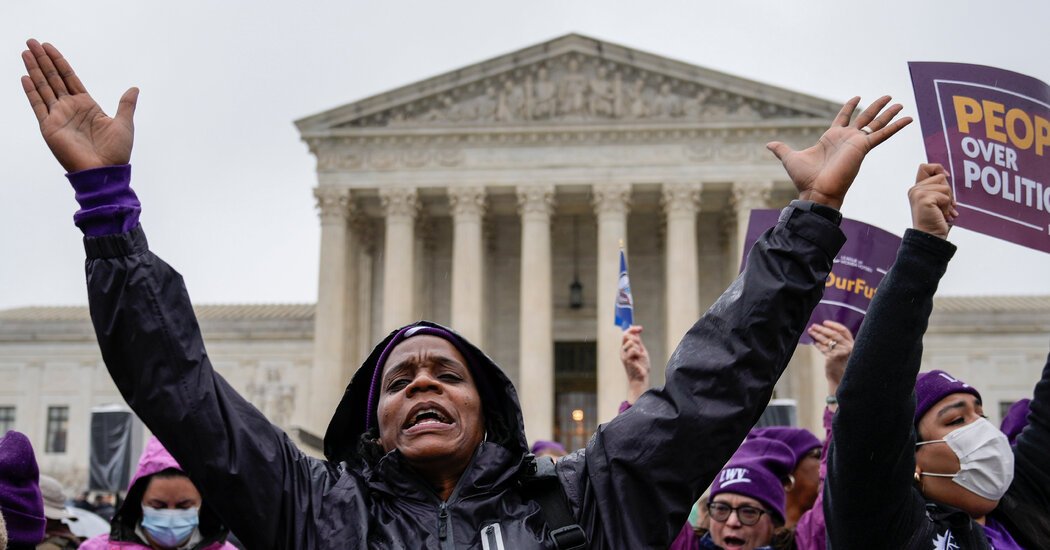Yesterday, the Supreme Court took a step in a high-profile case to preserve democratic checks and balances.
The details of the case, Moore v. Harper, can sound technical. But it is simply about which officials can oversee federal elections. The petitioner, a North Carolina lawmaker, had sought to radically reshape how federal elections are conducted. The court ruled that state legislatures do not have unchecked power over elections and that other government officials can question and overturn their decisions.
Chief Justice John Roberts and two other conservatives joined the court’s three liberals in the ruling. The Constitution, Roberts wrote, “does not exempt state legislatures from the ordinary constraints imposed by state law.”
Why does the ruling matter? Because it makes it more difficult for partisan state legislatures to flout the law or norms to keep their party in power, at a time when most legislatures have one-party supermajorities. Under the Supreme Court ruling, other officials can step in if they feel state lawmakers went too far in rewriting election law. The decision, then, could influence which party controls Congress in the future.
The stakes
The facts of the Supreme Court case help clarify the ruling’s potential impact. They offer a real-world example of how branches of government can check each other — in this case, courts over legislatures.
In 2021, lawmakers in North Carolina drew a voting map that would have likely given Republicans 10 of its congressional seats and Democrats four — a lopsided result in a state that is close to evenly divided politically. The state’s Supreme Court initially rejected the redrawn map. And in November, the state held elections with a map drawn by experts appointed by a state court. The result: a congressional delegation evenly divided between Democrats and Republicans, mirroring the state’s actual political makeup.
In short: Without the court, Republicans would have drawn a map that heavily favored their party. With the court’s intervention, the congressional map accurately reflected the state.
Last year, Republican lawmakers took the issue to the U.S. Supreme Court. They invoked what is known as the independent state legislature theory. They claimed the Constitution’s Elections Clause empowers only state legislatures, not courts, to set rules for congressional elections, including redrawing district lines.
The other side, made up of Democratic voters and advocacy organizations, argued that state legislatures’ election decisions should have many checks: the courts, governors, independent commissions and other officials empowered under the law.
The ruling
In yesterday’s decision, the Supreme Court rejected the independent state legislature theory. Roberts cited the long history of state courts reviewing and striking down state laws, and argued that nothing exempts election laws from such judicial review.
“The extreme version of the theory was soundly rejected, and by a six-justice majority,” my colleague Adam Liptak, who covers the Supreme Court, told me. “It would seem to be quite dead.”
It is the second time this month that Roberts and another conservative justice, Brett Kavanaugh, have joined the liberals in an election case. They also did so in a case over Alabama’s congressional map. The two rulings suggest there may be a moderate wing on voting issues in an otherwise conservative Supreme Court.
Three of the court’s conservatives dissented yesterday, largely on procedural grounds. After Republican lawmakers appealed the case to the U.S. Supreme Court last year, conservatives took over the North Carolina Supreme Court and reversed its previous ruling on the state’s congressional map. That eliminated the need for a U.S. Supreme Court ruling on the issue, the three justices argued. The court’s bipartisan majority disagreed.
For more
THE LATEST NEWS
Russian Revolt
Politics
Opinions
The Muslim holiday of Eid al-Adha falls on a different day each year. Taking the time off is a rebellion against our society’s approach to work, Romaissaa Benzizoune writes.
The loss of the Titan submersible proves that while regulation slows progress, it also saves lives, Naomi Oreskes argues.
Here is a column by Tom Friedman on Russia and Ukraine.
MORNING READS
DMs from N.Y.C.: Handwritten notes tell the city’s story — even what looks like a breakup message scrawled on a mattress.
Collective cringe: A TikToker is reading her old diaries aloud, helping viewers feel less embarrassed by their past selves.
Postpartum depression: Four new mothers spoke about their common yet isolating struggle.
Lives Lived: Bobby Osborne was a singer and mandolin player with one of the most radical bands in bluegrass. He died at 91.
SPORTS NEWS
The Bedard Era begins: Connor Bedard will be the No. 1 pick in tonight’s N.H.L. Draft. He enters the league with astronomical expectations, The Athletic writes.
Golf’s future: The PGA-LIV merger stands to profoundly reshape professional golf. But there’s still a chance the deal could fall apart, The Times explains.
Ryan Mallett: The former N.F.L. quarterback is dead at 35 after drowning in Florida, where he coached high-school football, The Athletic reports.
A major art auction: “Lady With a Fan,” a radiant portrait by Gustav Klimt that was on an easel when he died, sold for about $108 million at Sotheby’s in London yesterday. The purchase — the largest ever at a public sale in Europe — was a morale boost for Britain’s high-end art market, where prices have dwindled since the country voted to leave the E.U. in 2016, Scott Reyburn writes in The Times.





